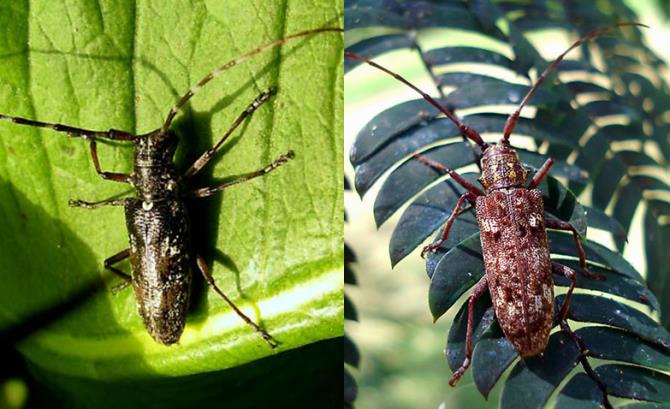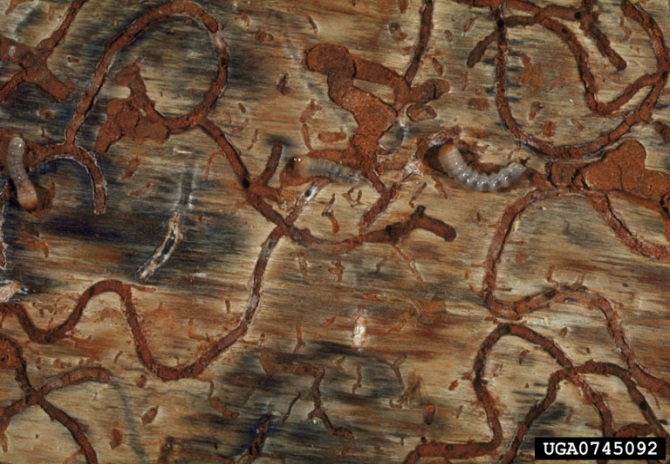
Sawyer beetles
| Primefact number | Edition | Published | Author |
|---|---|---|---|
| 1562 | First | Jun 2017 | Plant Biosecurity and Product Integrity |


![Figure 3 Exit hole chewed by Japanese sawyer beetle [approx. 9 mm] (Image: Jijing Song and Juan Shi, Beijing Forestry University, Bugwood.org) 9 mm hole in the surface of a tree trunk](https://www.dpi.nsw.gov.au/__data/assets/image/0010/1140958/SawyerBeetle3.jpg)
Sawyer beetles (Monochamus spp.) are not present in Australia. These pests are a serious threat to Australia’s forestry industries.
Sawyer beetles include beetles of the genus Monochamus. Introduction of these beetles is of concern to Australia due their role as a vector of pine nematode (Bursaphelenchus sp.), and the nematodes’ devastating impact on pine species.
Sawyer beetle species of particular concern are:
- Japanese sawyer beetle (M. alternatus)
- Black pine sawyer beetle (M. galloprovincialis)
- Obtuse sawyer beetle (M. obtusus)
- White spotted sawyer beetle (M. scutellatus)
- Southern pine sawyer beetle (M. titillator)
Description
Adults
Sawyer beetle adults are large, long-bodied beetles up to 30 mm in length. They vary in colour from mottled black, brown–grey to reddish brown with very long antennae up to twice as long as the body length (Figure 1).
Immature stages
Sawyer beetle larvae are legless, creamy white grubs found tunnelling beneath the bark. The larvae excrete frass (sawdust-like poo) which can be seen compacted in the larvae tunnels under the outer bark (Figure 2).
The eggs are about 4 mm in size, oval and yellowish-white, sometimes with a hint of brown.
Damage
On their own, sawyer beetles have very limited impact on infested host trees. The real damage risk comes from the sawyer beetles’ potential to carry and spread exotic species of pine nematode (Bursaphelenchus spp.).
Once introduced to a host tree by sawyer beetles, pine nematodes move through the tree in the water transport system. The feeding of nematodes on plant cells causes air pockets to form, disrupting water uptake by the tree. This leads to rapid death of the tree, often within a few weeks or months.
Lifecycle
The lifecycle of sawyer beetles is relatively slow, with one generation taking 1–2 years. The adults are sexually mature around one week after emerging from their pupa, though females require an average of three weeks to begin depositing eggs.
The eggs of sawyer beetles are laid into the bark of dying or felled host trees. Upon hatching, the larvae tunnel and feed through the inner bark, growing through four development stages before pupation.
When the adult emerges, it chews an exit hole about 9 mm in diameter in the bark of the tree (Figure 3). The adults live for about seven weeks on average.
Hosts
Sawyer beetles feed and reproduce on coniferous forestry trees. Pine trees (Pinus spp.) are the primary hosts, though other hosts include fir (Abies spp.), cedar (Cedrus sp.), larch (Larix spp.), and spruce (Picea spp.).
Spread
Sawyer beetles may be introduced to Australia as eggs, larvae or adults concealed within raw timber materials. This could include whole plant parts, timber for construction, timber packaging, wood chips or any other material produced from host trees.
Distribution
Species of Monochamus are currently restricted to the northern hemisphere, including North America, Asia and Europe.
Actions to minimise risk
Put in place biosecurity best practice actions to prevent entry, establishment and spread of pests and diseases:
- practice “Come clean, Go clean”
- ensure all staff and visitors are instructed in and adhere to your business management hygiene requirements
- monitor your crops regularly
- monitor and control weeds that can harbour the pest
- source plant material of a known high health status from reputable suppliers
- keep records

